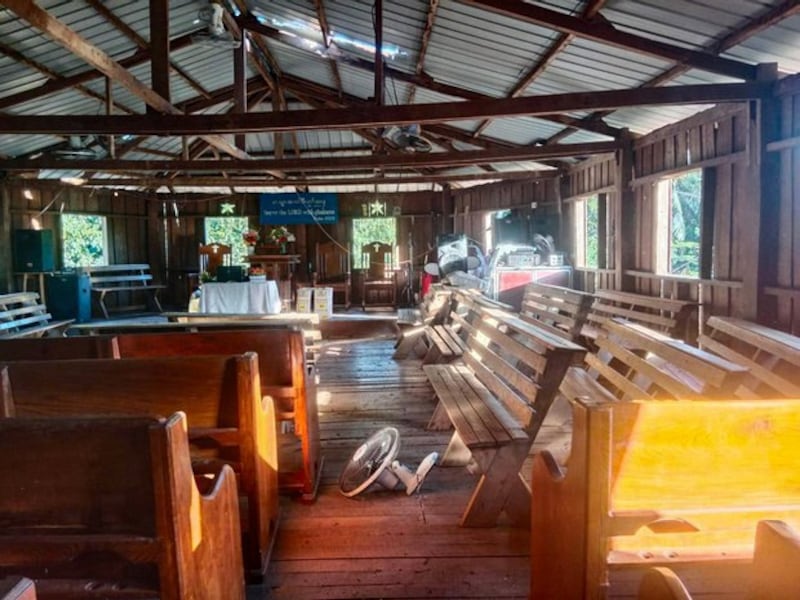Myanmar’s junta has focused much of its military firepower on Kayin state, carrying out 57 airstrikes on two key areas in January alone, highlighting the strategic importance of the area bordering Thailand rife with armed resistance groups and political opponents in hiding.
The state, across a river from the Thai border town of Mae Sot, is the stronghold of the Karen National Union, an armed ethnic group that has been fighting the government on and off for decades for more autonomy. Battle-hardened warriors, they’ve now joined the wider armed resistance against the military.
People who joined anti-junta activities after the 2021 coup – public sector employees who resigned as part of the so-called Civil Disobedience Movement, members of the independent media and political leaders – have also taken refuge en masse in KNU-controlled areas.
In the eyes of the military, it is a hotbed of rebellion strategically located in the middle of the country.
The military's push in Kayin state is driven by its ambition to crush the country’s armed resistance groups before a general election it plans to hold later this year, analysts and rebel groups say.
“Nobody can deny that the KNU is one of the organizations that has given the most support to the armed resistance – it shelters the most prominent members of the revolution and also cooperates with the armed resistance by providing military training and other forms of support,” said Lin Htet Aung, a military captain who defected to join the Civil Disobedience Movement.
“That’s why the military is targeting KNU – for its major role in the revolution.”
Relying on airstrikes
But ground offenses in Kayin state’s dense terrain have proved ineffective. That’s why the military is trying to “reshape the conflict” by using airstrikes, said KNU foreign affairs officer Pado Saw Taw Nee.
“The military considers these areas strategically important, so that is where most of its attacks are focused,” he said.
The junta’s 57 airstrikes on key KNU-held area last month killed 13 civilians, including a 2-year-old and two leaders of the Christian community, according to officials with the ethnic army.
Another reason the military is targeting the KNU is because many government soldiers have been captured as prisoners of war in areas controlled by the ethnic army’s 5th and 6th brigades, said Than Soe Naiung, a political analyst.
“The 5th and 6th Brigade areas are places where the junta has fought fierce battles in the past – especially in 2022, when the KNU raided its camps,” he said. “The KNU seized a lot of weapons and ammunition from the military and many junta troops were captured by the KNU in those areas, as well.”
“Out of the seven KNU brigades, the 5th and 6th are the strongest in spirit and attack against the junta, “ Than Soe Naing said. “That's why it seems that the military intends to crush them to weaken them.”
Schools, hospital destroyed
The airstrikes in January were carried out by junta fighter jets and helicopters in the KNU’s 5th Brigade-controlled area of Hpapun and 6th Brigade-controlled areas of Kawkareik, Kyainseikgyi and Myawaddy districts, the ethnic army said in a statement earlier this week.

A primary school, secondary school, public hospital, monastery, Catholic church and three Baptist churches were destroyed, and around 60 homes damaged by the attacks, the group said.
Ye El Na, the general secretary of the aid group Dawkalu Network, said that around 1,500 residents of 10 villages are displaced as a result of the conflict and “facing food and medicine shortages.”
The KNU claimed that the military dropped more than 200 bombs and fired some 30,000 rounds from its aircraft during the January airstrikes.
The KNU claims that 436 clashes took place within its territory in January, resulting in the deaths of 469 junta troops and members of the military-affiliated Kayin State Border Guard Force.
It said that 24 of its own fighters and those of allied forces have been killed in fighting and another 76 injured in the two years since the coup.
RFA was unable to independently verify the KNU’s claims.
When asked about the KNU’s reports of civilian casualties, Saw Khin Maung Myint, the junta’s economic minister and spokesman for Kayin state, told RFA that “the military never targets civilians.”
“They just fight the [anti-junta People’s Defense Force paramilitaries] and other armed groups,” he said.
“But if they are mixed in with civilians, [the military has] no other choice but to attack them all and some civilians may get hurt.”
Saw Khin Maung Myint said the military employs “modern technology such as night vision” equipment in its warplanes to differentiate combatants from civilians.
Displaced people
In the meantime, said Saw Nanda Su, a spokesman for the Karen Human Rights Group, the number of war refugees has “skyrocketed” due to military attacks in Kayin state since the new year.
“The number of refugees exceeded 300,000 at the end of 2022, but during the first couple of months of 2023, the airstrikes and artillery strikes have been nonstop,” he said. “That’s why the number of internally displaced people has skyrocketed – it’s up to 500,000 now.”
“Delivering humanitarian aid to anyone who isn’t close to the border with Thailand is an absolute nightmare,” he added.
Translated by Myo Min Aung. Edited by Joshua Lipes and Malcolm Foster.
